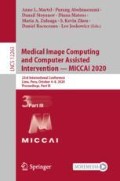Abstract
Accurate hepatic vessel segmentation and registration using ultrasound (US) can contribute to beneficial navigation during hepatic surgery. However, it is challenging due to noise and speckle in US imaging and liver deformation. Therefore, a workflow is developed using a reduced 3D U-Net for segmentation, followed by non-rigid coherent point drift (CPD) registration. By means of electromagnetically tracked US, 61 3D volumes were acquired during surgery. Dice scores of 0.77, 0.65 and 0.66 were achieved for segmentation of all vasculature, hepatic vein and portal vein respectively. This compares to inter-observer variabilities of 0.85, 0.88 and 0.74 respectively. Target registration error at a tumor lesion of interest was lower (7.1 mm) when registration is performed either on the hepatic or the portal vein, compared to using all vasculature (8.9 mm). Using clinical data, we developed a workflow consisting of multi-class segmentation combined with selective non-rigid registration that leads to sufficient accuracy for integration in computer assisted liver surgery.
B. R. Thomson and J. N. Smit—Equal contribution.
Access this chapter
Tax calculation will be finalised at checkout
Purchases are for personal use only
References
Askeland, C., et al.: CustusX: an open-source research platform for image-guided therapy. Int. J. Comput. Assist. Radiol. Surg. 11(4), 505–519 (2016)
Bø, L.E., Hofstad, E.F., Lindseth, F., Hernes, T.A.: Versatile robotic probe calibration for position tracking in ultrasound imaging. Phys. Med. Biol. 60(9), 3499 (2015)
Çiçek, Ö., Abdulkadir, A., Lienkamp, S.S., Brox, T., Ronneberger, O.: 3D U-Net: learning dense volumetric segmentation from sparse annotation. In: Ourselin, S., Joskowicz, L., Sabuncu, M.R., Unal, G., Wells, W. (eds.) MICCAI 2016. LNCS, vol. 9901, pp. 424–432. Springer, Cham (2016). https://doi.org/10.1007/978-3-319-46723-8_49
Dagon, B., Baur, C., Bettschart, V.: Real-time update of 3D deformable models for computer aided liver surgery. In: 2008 19th International Conference on Pattern Recognition, pp. 1–4. IEEE (2008)
Fusaglia, M., Tinguely, P., Banz, V., Weber, S., Lu, H.: A novel ultrasound-based registration for image-guided laparoscopic liver ablation. Surg. Innov. 23(4), 397–406 (2016)
Gibson, E., et al.: NiftyNet: a deep-learning platform for medical imaging. Comput. Methods Programs Biomed. 158, 113–122 (2018)
Guerrero, J., Salcudean, S.E., McEwen, J.A., Masri, B.A., Nicolaou, S.: Real-time vessel segmentation and tracking for ultrasound imaging applications. IEEE Trans. Med. Imaging 26(8), 1079–1090 (2007)
Ivashchenko, O.V., et al.: A workflow for automated segmentation of the liver surface, hepatic vasculature and biliary tree anatomy from multiphase MR images. Magn. Reson. Imaging 68, 53–65 (2020)
Khallaghi, S.: Pure numpy implementation of the coherent point drift algorithm (2017). https://github.com/siavashk/pycpd
Kumar, R.P., Albregtsen, F., Reimers, M., Edwin, B., Langø, T., Elle, O.J.: Three-dimensional blood vessel segmentation and centerline extraction based on two-dimensional cross-section analysis. Ann. Biomed. Eng. 43(5), 1223–1234 (2015)
Lange, T., Eulenstein, S., Hünerbein, M., Lamecker, H., Schlag, P.-M.: Augmenting intraoperative 3D ultrasound with preoperative models for navigation in liver surgery. In: Barillot, C., Haynor, D.R., Hellier, P. (eds.) MICCAI 2004. LNCS, vol. 3217, pp. 534–541. Springer, Heidelberg (2004). https://doi.org/10.1007/978-3-540-30136-3_66
Lee, T.C., Kashyap, R.L., Chu, C.N.: Building skeleton models via 3-D medial surface axis thinning algorithms. CVGIP: Graph. Models Image Process. 56(6), 462–478 (1994)
Lin, T.Y., Goyal, P., Girshick, R., He, K., Dollár, P.: Focal loss for dense object detection. In: Proceedings of the IEEE International Conference on Computer Vision, pp. 2980–2988 (2017)
Milko, S., Samset, E., Kadir, T.: Segmentation of the liver in ultrasound: a dynamic texture approach. Int. J. Comput. Assist. Radiol. Surg. 3(1–2), 143 (2008)
Milletari, F., Navab, N., Ahmadi, S.A.: V-Net: fully convolutional neural networks for volumetric medical image segmentation. In: 2016 Fourth International Conference on 3D Vision (3DV), pp. 565–571. IEEE (2016)
Mishra, D., Chaudhury, S., Sarkar, M., Manohar, S., Soin, A.S.: Segmentation of vascular regions in ultrasound images: a deep learning approach. In: 2018 IEEE International Symposium on Circuits and Systems (ISCAS), pp. 1–5. IEEE (2018)
Myronenko, A., Song, X.: Point set registration: coherent point drift. IEEE Trans. Pattern Anal. Mach. Intell. 32(12), 2262–2275 (2010)
Smistad, E., Elster, A.C., Lindseth, F.: GPU accelerated segmentation and centerline extraction of tubular structures from medical images. Int. J. Comput. Assist. Radiol. Surg. 9(4), 561–575 (2014)
Song, Y., et al.: Locally rigid, vessel-based registration for laparoscopic liver surgery. Int. J. Comput. Assist. Radiol. Surg. 10(12), 1951–1961 (2015)
Thomson, B.R., et al.: Hepatic vessel segmentation using a reduced filter 3D U-Net in ultrasound imaging. arXiv preprint arXiv:1907.12109 (2019)
Wei, W., et al.: Fast registration for liver motion compensation in ultrasound-guided navigation. In: 2019 IEEE 16th International Symposium on Biomedical Imaging (ISBI 2019), pp. 1132–1136. IEEE (2019)
Author information
Authors and Affiliations
Corresponding author
Editor information
Editors and Affiliations
Rights and permissions
Copyright information
© 2020 Springer Nature Switzerland AG
About this paper
Cite this paper
Thomson, B.R. et al. (2020). MR-to-US Registration Using Multiclass Segmentation of Hepatic Vasculature with a Reduced 3D U-Net. In: Martel, A.L., et al. Medical Image Computing and Computer Assisted Intervention – MICCAI 2020. MICCAI 2020. Lecture Notes in Computer Science(), vol 12263. Springer, Cham. https://doi.org/10.1007/978-3-030-59716-0_27
Download citation
DOI: https://doi.org/10.1007/978-3-030-59716-0_27
Published:
Publisher Name: Springer, Cham
Print ISBN: 978-3-030-59715-3
Online ISBN: 978-3-030-59716-0
eBook Packages: Computer ScienceComputer Science (R0)


